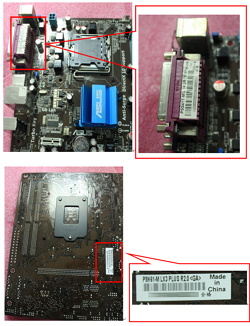Motherboard Manuals Model Number
When you upgrade other system components, it's sometimes important to know the details of the motherboard and chipset you're using. The motherboard's manual and manufacturer's web site are authoritative sources of information, of course, but at times you won't be certain which motherboard is installed in the system. The easiest way to identify the motherboard and chipset is to run a diagnostic utility such as Everest Home Edition. Figure 4-11 shows Everest Home Edition identifying a motherboard as an ASUS A7N8X-VM/400, with BIOS version 1003, dated 08/06/2004. Figure 4-12 identifies the chipset in this motherboard as an NVIDIA nForce2 IGP north bridge with an NVIDIA MCP2 south bridge.
Msi Motherboard Manual Pdf. You can find the model number and total number of manuals listed below. You can find the motherboard layout in Chapter 2. Find the name of the motherboard in your PC so that you can find the correct drivers and motherboard specifications. Type the model number of your computer into the field and click Next. Click the Product Information link.

Figure 4-11: Everest identifies a motherboard as an ASUS A7N8X-VM/400
My Motherboard Model Number
Figure 4-12: Everest identifies the chipset as an NVIDIA nForce2
Alas, it's not always possible to take the easy way out. Sometimes you have to pop the cover and actually examine the motherboard to get the information you need, because motherboard makers make slipstream revisions to their products without changing the model number. For example, an earlier revision of a motherboard may use voltage regulator modules (VRMs) that are rated to provide enough current only for processors that run at 2.8 GHz or slower. A later revision of that board, with the identical model number, may use VRMs that are rated for processors up to 3.8 GHz.
The revision number of a motherboard is ordinarily silk-screened on the board or printed on a paper label that is stuck to the board somewhere near the silkscreened model number or serial number. Most motherboard makers call their revisions by that name. Intel instead refers to its revision levels as AA numbers (Altered Assembly numbers). Figure 4-13 shows the label area of an Intel D865GLC motherboard, with an AA number of C28906-403
While it remains edgy, the area (like the station itself) has had something of a clean-up and facelift of late and is at least not as threatening as before. You will still find more chancers, con-men and agressive beggars here than anywhere else in the city, while you should also keep an eye out for pickpockets and rip-off taxi drivers. Mersul trenurilor.
Motherboard Model Number Location
Figure 4-13: Intel D865GLC motherboard with an AA number of C28906-403
Figure 4-14 shows a portion of the Intel CPU compatibility page for the D865GLC motherboard, which shows the minimum BIOS versions and AA numbers required for compatibility with various processors. Examining AA numbers tells us, for example, that our D865GLC motherboard, with an AA number of C28906-403, does not support Pentium 4 Extreme Edition processors, which require a minimum C28906 AA level of -405. You can find CPU compatibility pages on the motherboard manufacturer's web site (if the manufacturer doesn't provide this information, then you can add that manufacturer to the list of companies to avoid). The information you find online will generally be more upto-date than what you find in the manual that came with your motherboard.

Figure 4-14: Part of an Intel CPU compatibility page
If an early BIOS version is the only bar to upgrading a processor, you can simply update the BIOS to a later version. But if the board revision level is too low to support a particular processor, the only option is to use a different processor that is supported by the board revision level you have.
YOU CAN'T GET THERE FROM HERE
If you are upgrading to a faster processor (on a motherboard that supports it!) that requires a later BIOS version than you currently have installed, update the BIOS before you install the new processor. Otherwise, you'll find yourself in a 'can't get there from here' situation, because the system won't boot with the new processor.
Unsupported Means Unsupported
Never install an unsupported processor in the hopes that it may work. The good news is that it probably will. The bad news is that it won't for long. Faster processors draw more current, and it's likely that the fast new processor that appears to work fine is pulling more current than the motherboard was designed to provide. Sooner or later, probably sooner, that excessive current draw will damage or destroy the motherboard, and possibly the processor as well.